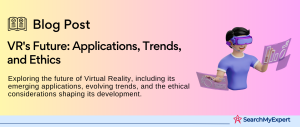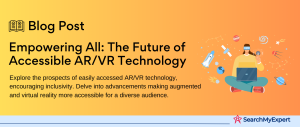Building AR/VR Development Skills
Welcome to the Immersive World!
Augmented Reality (AR) and Virtual Reality (VR) – these terms are more than just technological buzzwords; they represent a rapidly evolving field with transformative potential. AR/VR development stands at the cutting edge of innovation, offering unique experiences that blend the virtual and real worlds.
The Burgeoning Field of AR/VR
AR and VR technologies are breaking boundaries in how we interact with digital content. AR overlays digital information onto the physical world, while VR immerses users in a completely virtual environment. This blend of realities is reshaping sectors from education and healthcare to entertainment and retail, proving its versatility and wide-ranging impact.
Exciting Potential Across Various Industries
The potential of AR/VR is vast. In healthcare, it’s used for advanced surgical training. In education, it brings immersive learning experiences. In retail, it offers virtual try-on experiences. And in entertainment, it provides captivating gaming adventures. This versatility opens up a world of possibilities for creative and innovative applications.
Growing Demand for Skilled Developers
As AR/VR technologies continue to grow, so does the demand for skilled developers. These professionals are at the forefront of creating and implementing these immersive experiences. With AR/VR development skills, developers can enter a dynamic field with a plethora of opportunities, from creating interactive games to solving real-world problems.
Rewarding Career Opportunities
A career in AR/VR development is not just about being part of a technological trend; it’s about pioneering the future of digital interaction. For those passionate about pushing the boundaries of what’s possible, a career in AR/VR development offers a platform to innovate, inspire, and impact various aspects of daily life and work.
Understanding the Fundamentals
AR vs. VR: Know the Difference!
Understanding the distinction between Augmented Reality (AR) and Virtual Reality (VR) is crucial for anyone venturing into this field. Both technologies offer immersive experiences but differ significantly in their approach and application.
Augmented Reality (AR)
AR overlays digital information in the real world. It enhances the user’s current perception of reality by superimposing computer-generated images over their view of the real world. AR can be experienced through smartphones, tablets, or specialized AR glasses. Key uses include navigation systems, informational overlays in museums, and interactive marketing.
Core Functionality of AR:
- Enhancement of the Real World: AR adds digital elements to a live view, often by using the camera on a smartphone.
- Interactivity:
AR allows for interactions between real-world and digital elements. - Accessibility: Easily accessible via smartphones and tablets.
Virtual Reality (VR)
In contrast, VR replaces the real world with a simulated one. It immerses the user in a completely virtual environment, often using VR headsets or multi-projected environments. VR creates a simulated environment that can be similar to or completely different from the real world, often used for gaming, training simulations, and virtual tours.
Core Functionality of VR:
- Complete Immersion: Creates a fully immersive virtual environment.
- Isolation from Reality: Users are isolated from the real world, enhancing the virtual experience.
- Specialized Equipment:
Requires devices like VR headsets.
Mixed Reality (MR)
Mixed Reality (MR) is where the lines between AR and VR blur. MR combines elements of both AR and VR, anchoring virtual objects to the real world and allowing real-world and digital objects to interact. MR provides a more immersive experience than AR but still keeps the user grounded in the real world. It’s used in advanced applications like interactive product design and advanced gaming.
Mastering the Technical Toolkit
Coding Power Up!
In the realm of AR/VR development, mastering a suite of technical tools is key. These tools range from programming languages to game engines and 3D modeling software. Let’s dive in!
Essential Programming Languages
- C++:
Known for its high performance, C++ is a go-to for VR development. It powers many VR engines due to its speed and efficiency. - Java: Widely used in mobile AR applications, Java is essential for Android-based AR development. It’s known for its portability across platforms.
- C#:
The backbone of Unity, one of the most popular game engines. C# is user-friendly and ideal for those starting in game development. - Python: Known for its simplicity, Python is increasingly used in AR/VR for scripting and automation tasks.
Game Engines and Development Frameworks
- Unity: A powerhouse for both AR and VR development, Unity offers a user-friendly interface and a vast asset store. It’s compatible with multiple programming languages, primarily C#.
- Unreal Engine: Known for its high-fidelity graphics, Unreal Engine is a favorite for VR game development. It uses C++ and offers a unique blueprint system for those less code-savvy.
- XCode:
Essential for developing AR applications for iOS devices, XCode integrates well with ARKit, Apple’s AR development framework.
3D Modeling Software
- Maya:
A top choice for professional 3D modeling, Maya is used for creating detailed models and animations. - Blender: A free and open-source tool, Blender is great for beginners and professionals alike. It’s versatile for modeling, animation, and even game creation.
- ZBrush:
Specializing in sculpting and painting, ZBrush is ideal for creating highly detailed 3D models, especially for VR environments.
Designing for the Senses
UI/UX Design in the 3rd Dimension
In AR/VR development, UI/UX design takes on a whole new dimension. It’s not just about aesthetics; it’s about creating intuitive and immersive experiences that engage all the senses.
Importance of UI/UX in AR/VR
UI/UX in AR/VR is pivotal for user engagement and satisfaction. A well-designed interface ensures easy navigation, while a good user experience makes the virtual world believable and interactive. Unlike traditional 2D interfaces, AR/VR UI/UX design requires understanding spatial interactions and 3D design principles.
Spatial Design Considerations
- 3D Interaction:
Designing for AR/VR means thinking beyond flat screens. Interfaces must be intuitive in a 3D space, allowing users to move and interact naturally. - Environment Integration:
In AR, the UI should blend seamlessly with the real world, enhancing rather than obstructing the user’s view. - Navigation: VR environments need clear navigation cues. Users should easily understand how to move and interact within the virtual space.
Interaction Methods in Immersive Environments
- Gestural Controls:
AR/VR allows for natural gestural interactions. Designers must ensure these gestures are intuitive and mimic real-world actions. - Voice Commands:
Voice interaction can enhance the user experience, especially in VR, where traditional input devices are less accessible. - Haptic Feedback: Tactile feedback adds a layer of realism, helping users feel more connected to the virtual environment.
Sensory Feedback for Immersion
Sensory feedback is crucial in AR/VR for a believable experience. This includes not just visual and auditory feedback but also haptic (touch) sensations. Incorporating multiple senses enhances immersion and user engagement.
Building Your Portfolio
Start Small, Dream Big!
Creating a robust portfolio is crucial for any AR/VR developer. It’s not just about showing what you can do; it’s about telling a story of your journey, skills, and potential.
Hands-On Learning Through Personal Projects
- Experiment with Different Tools:
Don’t shy away from trying out various AR/VR platforms. Each project can teach something new. - Personal Projects:
Develop your own projects. They reflect your passion and creativity, showcasing your ability to bring ideas to life. - Iterative Learning:
Start with basic projects and gradually add complexity as your skills improve. This iterative approach is a great way to learn and grow.
Starting with Smaller Projects
- Begin with Basic Applications: Start with simple AR/VR applications before moving on to more complex ones. This will help you build a strong foundation.
- Focus on Quality: Even small projects should be polished and functional. Quality over quantity always stands out.
- Document Your Process:
Share your development journey for each project. This gives potential employers or clients insight into your problem-solving and creative processes.
Showcasing Skills in an Online Portfolio
- Online Presence:
Create a professional online portfolio. Platforms like GitHub, Behance, or your personal website can be excellent showcases. - Highlight Variety:
Include diverse projects that demonstrate a range of skills and interests in AR/VR. - Tell Your Story: Your portfolio should narrate your development journey, skills, and how you approach challenges.
Staying Ahead of the Curve
Embrace the Ever-Evolving Landscape
AR/VR technology is a fast-paced and ever-evolving field. Staying current and continuously learning is not just recommended; it’s essential.
The Rapid Evolution of AR/VR Technology
- Fast-paced Innovations:
AR/VR technologies are advancing rapidly, with new tools, platforms, and techniques emerging regularly. - Importance of Keeping Up: To remain relevant in the field, developers must stay informed about the latest advancements and incorporate them into their skill set.
Continuous Learning and Upskilling
- Ongoing Education: Engage in continuous learning through online courses, workshops, and industry conferences.
- Networking:
Join AR/VR communities and forums. Networking with peers can provide insights into emerging technologies and industry trends. - Experimentation: Hands-on experimentation with new tools and technologies is crucial. It allows developers to understand and apply new concepts in practical settings.
Exploring Emerging Trends
- Spatial Computing: Understand the concept of spatial computing, which combines the physical and digital worlds in a way that goes beyond simple screen interactions.
- Haptic Feedback:
Explore advancements in haptic technology that enable users to ‘feel’ virtual objects, adding a new dimension to it.
Join the AR/VR Community
Network, Collaborate, and Thrive!
Joining the AR/VR community is a game-changer for developers. It’s about building connections, sharing knowledge, and staying abreast of industry trends.
Joining Online Communities and Forums
- Online Platforms:
Platforms like Reddit, Discord, and LinkedIn groups are great for connecting with AR/VR enthusiasts and experts. - Participation:
Actively participate in discussions, ask questions, and share your insights. This engagement can lead to valuable connections and learning opportunities. - Stay Informed:
These platforms are often the first to discuss the latest trends and technologies in AR/VR.
Attending Meetups and Events
- Local and Global Meetups: Attend AR/VR meetups in your area or online. These gatherings are great for networking and learning from peers.
- Conferences and Workshops: Join conferences like VR/AR Global Summit or Facebook Connect. They offer a wealth of knowledge and networking opportunities.
- Workshops and Hackathons: Participate in workshops and hackathons. They’re not only learning experiences but also opportunities to showcase your skills.
Collaboration and Knowledge Sharing
- Collaborate on Projects: Team up with fellow developers on projects. Collaboration can lead to innovative solutions and learning from each other’s experiences.
- Mentorship:
Seek mentors and offer mentorship. Sharing knowledge is a two-way street that benefits the entire community. - Stay Updated: Regularly interact with the community to stay updated on the latest advancements and best practices in the field.
Conclusion
In this roadmap to building AR/VR development skills, remember that the journey is as exciting as the destination. From understanding the fundamentals of AR and VR to mastering a variety of technical tools, designing for immersive experiences, building a compelling portfolio, staying current with industry trends, and engaging with the vibrant AR/VR community, each step is a milestone in your development journey.
The world of AR/VR is dynamic, challenging, and immensely rewarding. It’s a field that not only demands technical proficiency but also creativity and a continuous appetite for learning. As you embark on this journey, embrace the challenges and opportunities that come your way. Whether you’re aiming to become a pioneering developer or to innovate within this space, the AR/VR world is your digital canvas. Dream big, stay curious, and forge your path in this exciting frontier of technology.
Immerse in innovation with our AR & VR Development Service Services.
Table of Contents
Toggle






